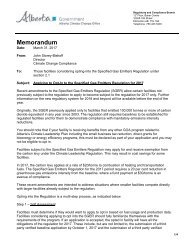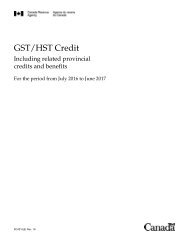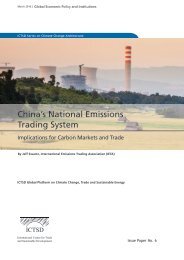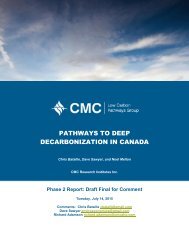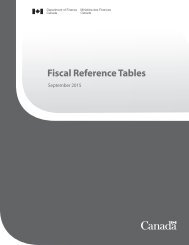MAKE THE ALBERTA CARBON LEVY REVENUE NEUTRAL
carbon-levy-revenue-neutral-mckenzie
carbon-levy-revenue-neutral-mckenzie
Create successful ePaper yourself
Turn your PDF publications into a flip-book with our unique Google optimized e-Paper software.
above, the tax will lead to behavioural changes on the part of consumers and producers<br />
as they use less fossil fuel, and society will benefit from a reduction in the associated<br />
externalities. This is the first dividend. If the $1 in tax revenue is then simply returned to<br />
consumers/taxpayers in a lump sum manner, that would be the end of it. While society<br />
benefits from the reduction in the externalities caused by carbon usage, generating the first<br />
dividend, because the government takes $1 away with one hand and gives it back with the<br />
other by way of a non-distortionary lump sum transfer, there is no second dividend.<br />
However, because most taxes give rise to costs over and above the tax revenue raised, an<br />
alternative approach would be to return the incremental $1 in revenue from the carbon<br />
tax to taxpayers by way of a reduction in an existing distortionary tax; for example, the<br />
provincial CIT. In other words, undertake a revenue-neutral tax swap, replacing $1 in<br />
tax revenue from the CIT with $1 in tax revenue from the carbon tax. Using Dahlby’s<br />
and Ferede’s MCF calculations, reducing provincial CIT revenues by $1 will generate<br />
an additional benefit of $2.79 in reduced efficiency costs over and above the $1 in tax<br />
revenue given up; this $2.79 is the second dividend. This reasoning would seem to suggest<br />
that recycling carbon taxes in a revenue-neutral manner, reducing existing distortionary<br />
taxes dollar for dollar, gives rise to the fabled free lunch – we can have our cake (a better<br />
environment) and eat it, too (a less distortionary, more efficient tax system).<br />
It turns out, however, that this view is somewhat oversimplified, and most analytical and<br />
numerical studies of the issue conclude that a double dividend is unlikely to be realized in<br />
practice. 15 While the first dividend – the benefits of mitigating climate change – is not in<br />
dispute, the second dividend – an improvement in the overall efficiency of the tax system –<br />
is questionable. In the above example, it was assumed that the MCF associated with raising<br />
$1 with a carbon tax was simply $1; in other words, there was no incremental efficiency<br />
cost associated with the carbon tax. It turns out that this is not the case. The reason for this<br />
is that carbon taxes exacerbate the efficiency costs associated with existing distortionary<br />
taxes, potentially (and indeed likely) rendering the second dividend negative, and increasing<br />
the overall efficiency costs of the tax system, even if the revenue is fully recycled in a<br />
revenue-neutral manner. This is often referred to as the tax interaction effect.<br />
One way of thinking about the tax interaction effect is as follows. Carbon taxes cause the<br />
costs and prices of products that use energy to rise. This results in effects that are similar<br />
to an increase in existing taxes on labour and capital, which discourages labour supply<br />
and investment, thereby exacerbating the efficiency costs associated with the existing<br />
tax distortions in labour and capital markets. Consider the labour market. The rise in the<br />
prices of goods and services due to the carbon tax results in a reduction in real wages, as<br />
the amount of goods and services that a consumer can purchase declines due to higher<br />
prices. This reduction in real wages has a similar impact to an increase in the tax on labour<br />
income, which lowers after-tax wages directly, and therefore increases the efficiency costs<br />
associated with existing taxes on labour income. Thus, in some ways, the carbon tax acts<br />
like an increase in the tax rate on labour income (actually, it is worse, as I will argue<br />
below), with an associated rise in efficiency costs.<br />
15<br />
I do not go into the details of individual studies here. For surveys of the literature and more in-depth analysis, see Goulder<br />
(1995), Parry (1995), Bovenberg and Goulder (1998), Bovenberg (1998), and Bovenberg (1999).<br />
8



